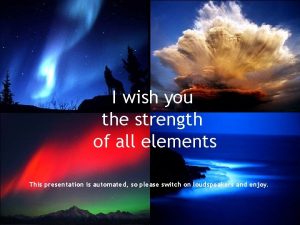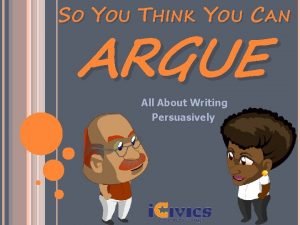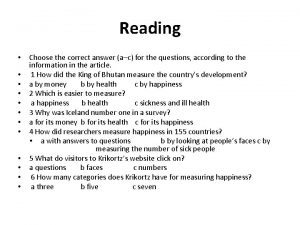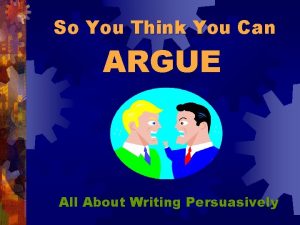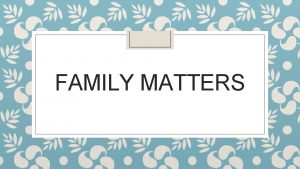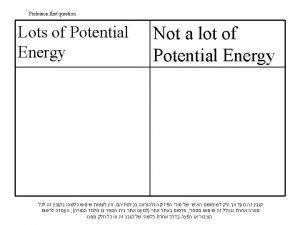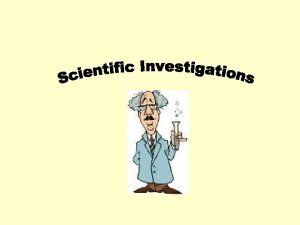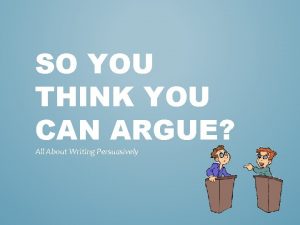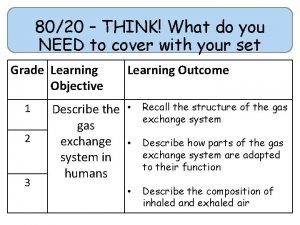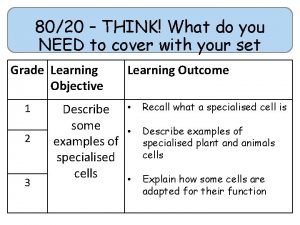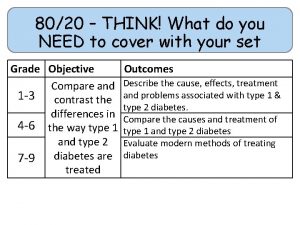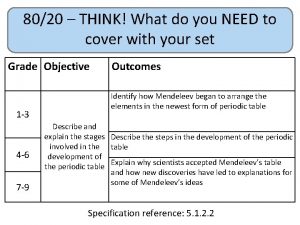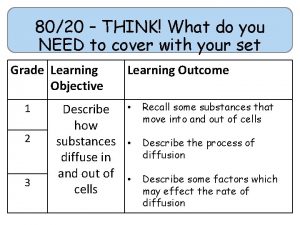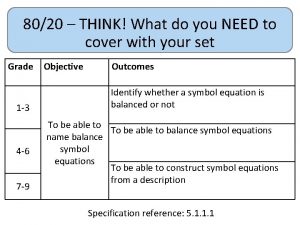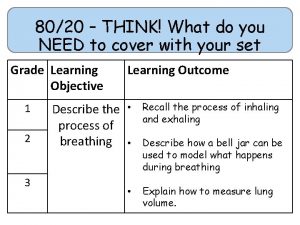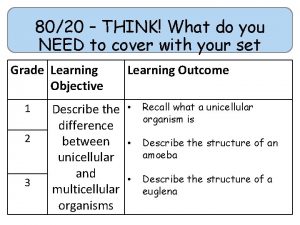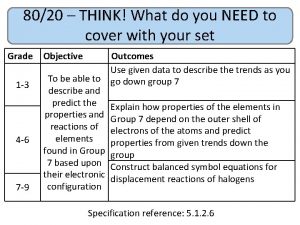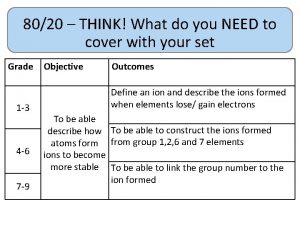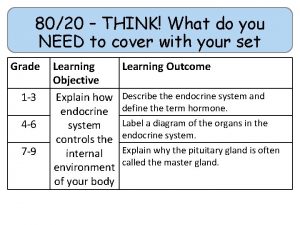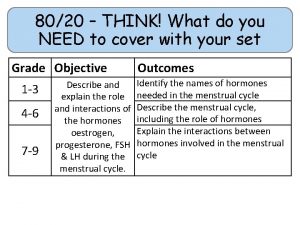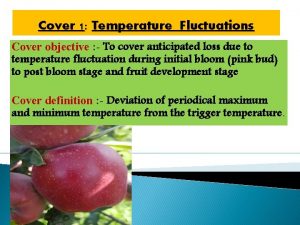8020 THINK What do you NEED to cover






















- Slides: 22

80/20 – THINK! What do you NEED to cover with your set Grade 1 -3 4 -6 7 -9 Objective Outcomes Recall the different charges of the particles that make up an atom To be able to Be able to use the periodic table to describe the identify the number of protons in structure of different elements an atom Explain why atoms have no overall charge Specification reference: 5. 1. 1. 4 and 5. 1. 1. 5

CWK 21 February 2021 Atomic structure DO IT NOW – Classify the substances as elements or compounds ELEMENT COMPOUND Challenge- Can you name any substances the different diagrams could show?

Progress indicators GOOD PROGRESS: OUTSTANDING PROGRESS:

Word consciousness Sub-atomic particle – part of an atom Neutral – no charge

Task – watch the video and when asked to record write down the key information about the 3 parts of the atom https: //www. youtube. com/watch? v=4 sl-E_l_1 pk

Sub-atomic particles Sub-atomic particle Location Charge Mass PPROTON NUCLEUS +1 1 EELECTRON SHELLS -1 1/2000 NNEUTRON NUCLEUS 0 Very small 1

Mini-plenary: True or false? 1. An atom contains four sub-atomic particles 2. A neutron is positively charged 3. The nucleus contains protons and neutrons 4. Electrons are found in the nucleus of an atom 5. Electrons are negatively charged

True or false? 1. An atom contains four sub-atomic particles

True or false? 2. A neutron is positively charged

True or false? 3. The nucleus contains protons and neutrons

True or false? 4. Electrons are found in the nucleus of an atom

True or false? 5. Electrons are negatively charged

How do you calculate protons, electrons and neutrons? Mass number 19 F 9 Symbol Atomic number

How many protons? Mass number 19 F Symbol 9 24 Mg 12 12 Atomic number 35. 5 Cl 17 39 K 19 65 Zn 30 27 Al 13 17 19 30 13 The number of electrons is equal to the number of protons so an atom has no overall charge

How many neutrons? Number of neutrons = mass number – atomic number Atom Mass number Atomic Number of Neutrons Helium 4 2 2 Fluorine 19 9 10 Lead 207 82 125 Sodium 23 11 Iodine 127 53 12 74


Write out how many protons, neutrons and electrons for the following. Element P E N Sodium 11 11 12 Potassium 19 19 20 Iron 26 26 30 Gold 79 79 118 Radon 86 86 136 Challenge: Draw an atom diagram to illustrate an oxygen atom

Calculating atomic and mass number e. g. An atom has 7 protons, 7 electrons and 7 neutrons, what are the atomic and mass numbers? Atomic number = number of protons = 7 Mass number = protons and neutrons = 7+7 = 14

Application Calculate the atomic and mass numbers for: 1. Atom X has 15 protons, 15 electrons and 16 neutrons. 2. Atom Y has 45 protons, 45 electrons and 52 neutrons. 3. Atom Z has 123 protons, 123 electrons and 125 neutrons.

Application Calculate the atomic and mass numbers for: 1. Atom X has 15 protons, 15 electrons and 16 neutrons. Atomic number = 15, mass number = 31 2. Atom Y has 45 protons, 45 electrons and 52 neutrons. Atomic number = 45, mass number = 97 3. Atom Z has 123 protons, 123 electrons and 125 neutrons. Atomic number = 123, mass number = 248

Plenary A 1. Label the sub-atomic particles in the diagram: A = ________ B = ________ (2) B 2. a) Which sub-atomic particle has a positive charge? (1) b) Which sub-atomic particle is NOT found in the nucleus? (1) 3. Use the periodic table to find the number of protons, neutrons and electrons in: a) Neon b) Phosphorus (6)

SELF-ASSESS IN RED A B 1. Label the sub-atomic particles in the diagram: Neutron A = ________ Electron B = ________ (2) 2. a) Which sub-atomic particle has a positive charge? (1) Proton b) Which sub-atomic particle is NOT found in the nucleus? (1) Electron 3. Use the periodic table to find the number of protons, neutrons and electrons in: a) Neon P = 10, E = 10 and N = 10 b) Phosphorus P = 15, E = 15 and(6)N = 16
 Dvx-9000
Dvx-9000 Dream with eyes open
Dream with eyes open If you think you can you can poem
If you think you can you can poem Alternative cover test
Alternative cover test Alternate prism cover test
Alternate prism cover test Forced duction test procedure
Forced duction test procedure I wish you all the strength
I wish you all the strength Punctuating split speech
Punctuating split speech Think said the robin
Think said the robin Think family ni
Think family ni So you think you can argue
So you think you can argue Choose the correct answers a-c
Choose the correct answers a-c So you think you can argue
So you think you can argue So you think you know minecraft
So you think you know minecraft What comes to your mind when you hear the word family
What comes to your mind when you hear the word family You have more potential than you think
You have more potential than you think What do you think of when you hear the word science?
What do you think of when you hear the word science? What do you think of when you hear
What do you think of when you hear You can argue
You can argue What did you see from the cover
What did you see from the cover It can be quite busy here during the tourist
It can be quite busy here during the tourist English paragraph
English paragraph You only need to be lucky once
You only need to be lucky once






